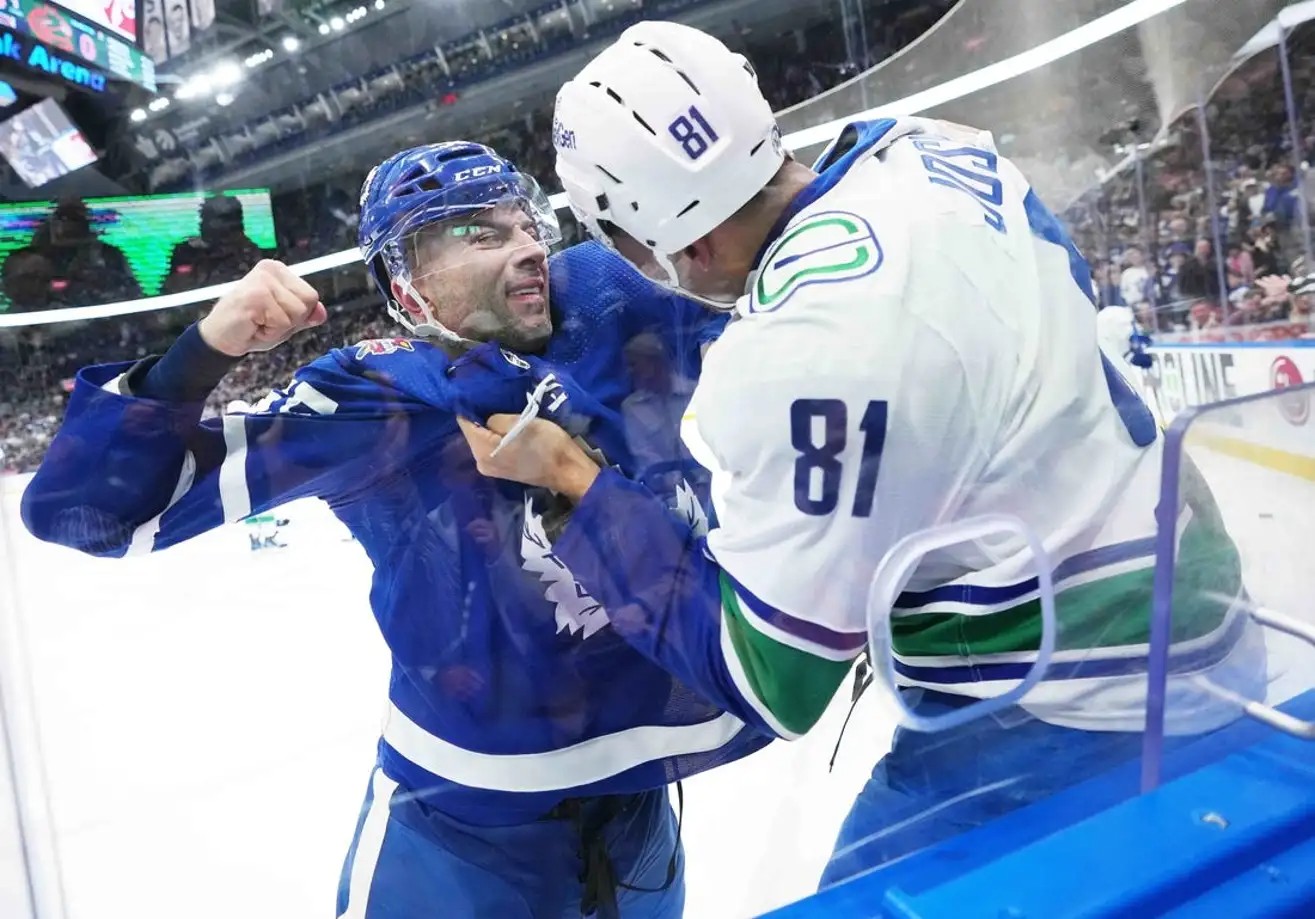The Maple Leafs allowed fewer than four goals on home ice (finally) and received meaningful offensive contributions from the bottom six, fuelling an impressive, stress-free win over the red-hot Canucks on Saturday night.
Stress-free wins (or at least relatively stress-free) have been a rare treat for the Leafs this season. It seems like every game this season has either been a carnival or a disappointment. It’s been few and far between when it comes to genuinely solid performances in which the win felt secure well in advance of the final buzzer.
It sure didn’t seem as though that would be the case after the first period on Saturday. Alas, the Leafs managed to turn it around and manufacture an all-around solid game from top to bottom throughout the lineup, shutting out the league’s top even-strength offense during five-on-five play. Not a bad way to head into the Sweden trip.
Your game in 10:
1. For multiple reasons, the story of the first period was the pair of instigator penalties taken when (40-year-old!) Mark Giordano and Max Domi responded to big hits on David Kampf and Nick Robertson by dropping the gloves with Dakota Joshua and Ian Cole, respectively. It was a clear — and refreshing — response to the mandate the team spoke about after the Marchand-Liljegren incident whereby the team should consistently and immediately stand up for each other after liberties are taken. The energy it injected into the building was palpable.
It also led directly to two Canucks goals on the power play. This is where a penalty kill needs to rally around a “worthwhile penalty” (x2) and dig in extra deep to get the kill, but the PK let the team down again twice in the first period. The four-man units looked out of sync in terms of their spacing as the Canucks — much like many other opponents in the early stages of this season — were able to work passes through open seams too easily.
The actual goals were JT Miller beating Ilya Samsonov from the top of the circle (with an assist to a Brock Boeser screen) and a rebound goal by the Canucks’ second unit (Pius Suter finished it off), but there was an air of inevitability to Vancouver scoring, which has been a familiar feeling when the Leafs are down a man this season.
2. In between Canucks power-play goals, Tyler Myers took a penalty that gave Toronto their own man-advantage opportunity. The top unit couldn’t capitalize, but they had a few looks with an emphasis on puck movement down low.
Just as the penalty was about to expire, the second unit cashed in. Tyler Bertuzzi sent a pass across to Calle Järnkrok, who fired a shot wide and then sent a pass behind the net back to Bertuzzi. All of the Canucks’ PKers ended up in the same small radius near the endboards as Bertuzzi sent a pass out to Max Domi, who was open in the slot.
One of the Canucks defenders recovered in time to block the shot, but the rebound went right to Bertuzzi, who jammed it into the crowd at the net. His shot somehow didn’t cross the line, but Matthew Knies was on the doorstep to hammer it home to draw the game even at 1-1.
It was essentially a second-unit goal — even though the stat sheet won’t show it as a PPG — and that’s a welcome bit of secondary power-play scoring at a time when the Leafs‘ power play has cooled off in the month of November with just three goals in their last six games.
3. When the Suter goal made it 2-1 late in the period, it felt like the game could have started to get away from Ilya Samsonov. He overplayed the initial shot on the 2-1 goal, losing his bearings in the net somewhat — this tends to be the tell-tale sign of when he’s off his game — and gave up the big rebound into the slot with an empty net for Suter to shoot into.
Coming off of Samsonov’s pull against Tampa leading into two wobbly Joseph Woll starts vs. Ottawa and Calgary, the Leafs needed a goaltender to settle his game down on home ice and keep the opponent to three or fewer at some point. Thankfully, the response from Samsonov — and the PK — was really solid in the final 40 minutes.
4. Opening the middle frame, the Leafs needed a better start to the period. The shots on goal weren’t totally representative of the run of play at five-on-five, but after the first 20 minutes, they recorded as many minor penalties as shots on net. There was something to galvanize the team and rally around with the first-period fights; they just needed to get their offense going, and it needed to start with getting more pucks and bodies to the net.
A couple of minutes into the period, the Bertuzzi-Tavares-Nylander combo stepped over the boards. William Nylander sliced into the middle of the offensive zone and sent a pass across to Bertuzzi, but he was robbed by Thatcher Demko. After a short scramble behind the net, the puck was sent back into the slot. John Tavares managed to work the puck free and poke it to Nylander, who displayed excellent patience to out-wait Demko and throw it out front, where it bounced off of a sprawling Tyler Myers’ knee and in.
It’s always remarkable to watch Nylander’s calmness and patience with the puck in the crowded areas of the ice, and also how he can scramble an opposing defense with an incisive structure-breaking move like the one that initially scattered the Canucks defense prior to the goal.
5. The middle 10 minutes featured a lot of power-play time for both sides. Vancouver had a brief 5v3 following a too-many-men penalty against the Leafs (how many more of these are they going to take before they clean it up!?), but they couldn’t capitalize as the PK started to tighten the screws finally.
The Leafs got their own 5v4 chance a few moments later, and the top unit went to work. William Nylander ripped multiple one-timers that were turned away by Demko, and Auston Matthews‘ shot from the slot was stopped as well. They didn’t break through, but it wasn’t for a lack of trying.
With the top unit and the top line struggling to solve Demko, depth scoring stepped up a short time later with a goal from an unlikely source.
6. The zip on Noah Gregor‘s shot is a little underrated (understandably, because he often isn’t on target with it or finds the goalie’s crest), but he owns a good release and can lean into a wrist shot. He cleanly beat one of the hottest goalies in the league straight up from just inside the top of the circle for the 3-2 goal that ultimately stood up as the game-winner.
It was a subtle play by David Kampf to let the pass go through to Gregor, and Morgan Rielly created the entire sequence by identifying the opportunity presented by a wide-open neutral zone to jump up ice for a rush opportunity off of the transition.
7. The top line didn’t find the scoresheet in this game (although Knies did score on the second-unit PP), but there was a subtle contribution that set the stage for Nick Robertson‘s 4-2 insurance goal, one that demonstrates the importance of commitment to detail late in a shift.
Rather than going through the motions to end their shift, Auston Matthews and Matthew Knies dug deep to force the Canucks back inside their own zone before peeling off for the change. It’s a little thing but a big thing; it set the next line up for success by starting their shift on the front foot in the offensive zone.
As the puck made its way back to the point, Morgan Rielly sent it back around the boards behind the net. Quinn Hughes briefly held possession for Vancouver, but Max Domi stole it right back and poked it out front, where a charging-in-off-the-bench Robertson fired a quick backhand past Demko shot to extend the lead.
This third line has been really effective at hurrying opposing defenses into mistakes with their speed and being quick onto loose pucks. Once in possession, the line is gelling together nicely with Domi’s playmaking skill alongside two shooting wingers who can bury.
8. The night for Hughes only got more frustrating after his turnover resulted in a goal against. After making a nice move to open up some ice, he ripped a shot over the shoulder of Samsonov, but it rang off the bar and out.
Moments later, the Leafs’ fourth line scored their second of the night on a fairly innocent-looking shot. Gregor turned and fired it as he skated towards the point, and David Kämpf was able to deflect it in while Hughes afforded him free rein in front of the net.
With the game firmly in hand at 5-2, the final stages were comfortably pedestrian and drama-free.
9. The fourth line coming alive offensively (including two assists to Bobby McMann, who added some extra jump to the trio) is obviously a large part of the equation when it comes to the discussion about Ryan Reaves‘ spot in the lineup going forward, but it’s also specifically worth mentioning the physical element. Ironically, the Leafs played arguably their most physically engaged game as a team as soon as he came out of the lineup.
The events around the Kampf and Robertson hits in the first period proved an important point: The response in these moments needs to come from a culture of team toughness, not from one player who barely plays and is struggling to positively impact the game at either end of the ice.
Reaves is in almost the exact situation that he was last year.
The Rangers decided to move on after 101 minutes.
He's now at 105 with Toronto, and it's somehow been a little bit worse.
Have to wonder if a change is coming soon. pic.twitter.com/R4MHEsnZSr
— Kevin Papetti (@KPapetti) November 11, 2023
10. Considering all the circumstances coming into this game, everything on paper suggested this could be a tough night. The Canucks came into Saturday night as the highest-scoring team in the league, the Leafs had allowed at least four goals in every home game, Ilya Samsonov was coming off a frustrating game that he got pulled from in the first period, and the Leafs were on the second half of a back-to-back. But this was one of the better games the Leafs played as a team all season thus far.
This might have been the best the Leafs have looked as a collective over four lines and three pairings. In addition to scoring five goals against an elite goalie with zero points from Matthews or Marner, it was also notable that it all started with physical engagement. Even putting the two fights aside, this was the most invested the Leafs have looked physically this season; there seemed to be a bit more pushback any time the Canucks tried to bully them around.
This has the potential to be a galvanizing win and a kind of “model” for the team to refer back to in terms of what they can accomplish when all hands are on deck, they play connected over 200 feet, and they have each other’s backs.
Game Flow: 5v5 Shot Attempts

Heatmap: 5v5 Shot Attempts



































